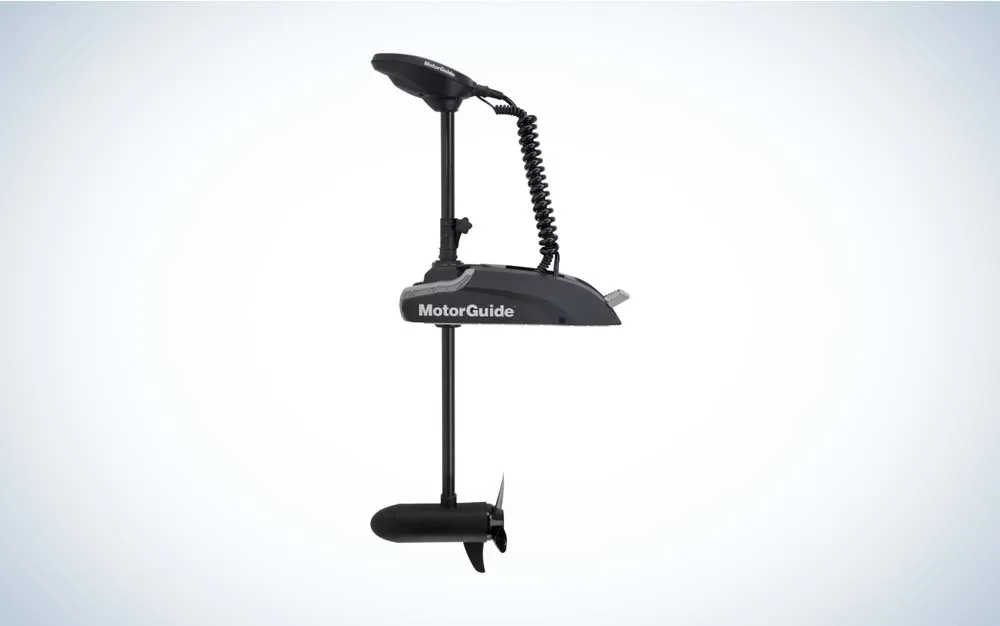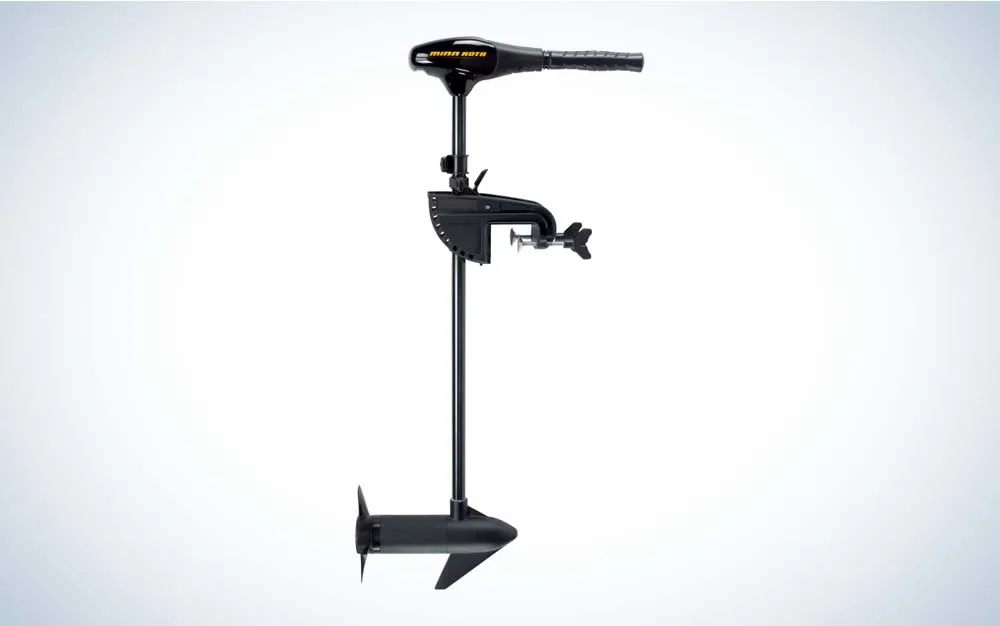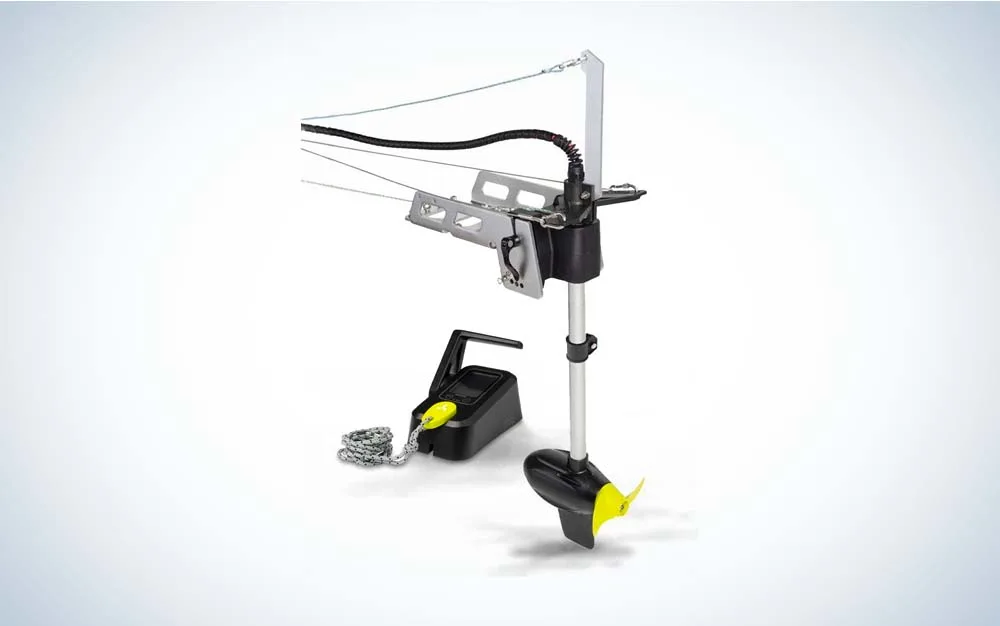_We may earn revenue from the products available on this page and participate in affiliate programs. Learn more ›
_
Best Overall

MotorGuide Xi3 Freshwater Kayak Trolling Motor
Best Compact

Bixpy Outboard Motor Kit
Best Budget

Minn Kota Endura C2 Transom
Kayak motors can turn a boat that excels in shallow water into a vessel capable of handling open water conditions, wind, and more. The beauty of kayaks is they are easy to transport, can be launched from anywhere, and are affordable. In addition, they have always offered anglers a stealthy approach into areas other boats can’t reach. The only issue is getting to those areas, especially on big water bodies. A recent surge of great kayak trolling motors opens up many options for anglers, including some impressive offshore models. These motors enable anglers to move fast, cover water, and, when the time comes, raise the motor and sneak up on fish. Here are our picks for the best kayak motors in 2023.
Best Overall: MotorGuide Xi3 Freshwater Kayak Trolling Motor
Best Compact: Bixpy Outboard Motor Kit
Best for Speed: Newport NK180 Kayak Trolling Motor w/ Mounting & Steering Bracket Kit
Best for Saltwater: MotorGuide Xi3 Kayak Saltwater Trolling Motor with Pinpoint GPS
Best Budget: Minn Kota Endura C2 Transom
How We Picked the Best Kayak Motors
I’ve spent more hours paddling kayaks to remote honey holes and marshes than I care to admit. After grueling paddles, I always wonder why I don’t have a motor on my kayak. To save my back and get to spots quicker, I tested every variation of a kayak motor. These motors had to get me where I needed but stay out of the way when its time to fish. I evaluated my selections on the following criteria:
Speed: What is the top speed of the motor?
Stowing: Does it stow away to fish in shallow water?
Battery Life: How long does the battery life last, and what battery is needed?
Steering: How do you control the motor?
Weight: How heavy is the motor and battery combination?
Durability: Is the motor built to withstand many fishing seasons?
Best Kayak Motors: Reviews & Recommendations
Best Overall: MotorGuide Xi3 Freshwater Kayak Trolling Motor

Specs
Steering Control: Wireless remote
Battery Type: 12-volt system with a lead acid or lithium-ion battery
Weight: 40 lbs.
Pros
Quiet motor
Easily controlled with a wireless remote
55 lbs of thrust moves kayaks well
Cons
No GPS pinpoint
Traditional trolling motors are gaining popularity in the kayak fishing world. They offer the best compromise between speed and control. The MotorGuide Xi3 Freshwater Kayak motor is built like the standard Xi3 but in a kayak-sized package. The shaft length is 36 inches long and easy to deploy. It is the perfect length to operate in various depths and takes up minimal space when raised. Similar to its big boat counterparts, a simple wireless remote operates it. The 5-button layout allows users to steer left and right, control their speed, and switch it on and off. Various batteries are compatible to power this 12-volt system but lithium-ion batteries will maximize performance. The system is also NMEA 2000 compatible and ready to be paired with charter plotters for ultimate control.
Best Compact: Bixpy Outboard Motor Kit

Specs
Steering Control: Wireless remote
Battery Type: Bixby Outboard Battery
Weight: 9 lbs.
Pros
Lightweight
Can be mounted on virtually any personal watercraft
Forward and reverse
Cons
It runs on a proprietary battery
At just nine pounds for battery and motor, the Bixpy is a marvel of engineering. The tiny but powerful kayak outboard motor runs off a matching lithium-ion battery and generates 30 pounds of thrust. Forward and reverse speeds are controlled with a wireless remote (which floats). This tough little unit is also waterproof and dirt-proof. The modular motor can quickly move between kayaks or attach to a standup paddleboard. The battery only powers the motor at full speed for 75 minutes, but the compact jet will run for 10 hours at a slow speed. Bixpy matches the system with various accessories, making it easy to install on almost any kayak.
Best for Speed: Newport NK180 Kayak Trolling Motor w/ Mounting & Steering Bracket Kit

Specs
Steering Control: Rudder steering or paddle steering
Battery Type: 24V Lithium, AGM, or Lead Acid Deep Cycle Batteries
Weight: 18 lbs.
Pros
Easily mounts on a variety of kayaks
Far range
Intuitive controls, including reverse and deploy
Cons
Requires a 24-volt battery system
Stern mount kayak motors are great for anglers looking to cover a lot of water quickly. Newport’s NK180 is a powerful and affordable option compatible with most vessels. The installation is relatively straightforward; four bolts mount the motor plate to the back of your kayak. It’s powered by a 24-volt battery system capable of traveling up to 63 miles on a single charge. Anglers can drop in a single 24-volt battery or two 12-volt batteries rigged in series. Two batteries are heavy, so make sure your kayak is large enough to handle the extra weight and has the storage for the batteries. Unlike traditional trolling motors, the motor gets mounted in a fixed position. Anglers can use a rudder for hands-free steering or a paddle to control the boat. Come time to fish, a hands-free pulley allows you to raise the motor without reaching behind yourself.
Best for Saltwater: MotorGuide Xi3 Kayak Saltwater Trolling Motor with Pinpoint GPS

Specs
Steering Control: Remote control
Battery Type: 12-volt system
Weight: 42 pounds
Pros
Saltwater capable
Precise control
GPS locking capabilities
Cons
GPS locking increases the cost
Like MotorGuide’s Xi3 Freshwater motor, the Xi3 Kayak Saltwater motor is built with kayak anglers in mind. It features the same 36-inch shaft and runs off a 12-volt battery system. Size-wise, it fits most ten to twelve feet fishing kayaks and is simple to operate. The GPS locking feature makes the remote a little more complicated, but you’ll be thankful you have it. My biggest issue with kayak fishing is keeping a small boat in place while I fish. Even the slightest wind or current makes staying on top of structure or schooling fish a challenge. The Xi3 allows anglers to click one button, and the motor will keep you locked in place no matter the conditions. This unit is ready to pair with Lowrance, Simrad, and Mercury fish finders for those wanting ultimate control. Anglers can navigate by recording tracks and dropping waypoints to anchor on.
Best Budget: Minn Kota Endura C2 Transom

Specs
Steering Control: Handheld tiller control
Battery Type: 12-volt system
Weight: 25 pounds
Pros
Affordable
Reasonably lightweight
Easy to install
Cons
Tiller steering
Most fishing kayaks have a squared-off end perfect for transom mount motors like the Minn Kota Endura C2. This motor is an affordable means of covering large water bodies. The mount is a simple C-clamp style and can be removed with the twist of two bolts. Like most small outboards, this is a tiller-style motor. The handle controls the throttle and steering direction. This motor comes ready with forward and reverse and a built-in tiller extension. On longer kayaks, the extension allows you to operate the motor with minimal strain. At a quarter of the price of most kayak motors, the C2 is a great option to get to the areas you plan to fish. Once there, I typically fold the motor up and start paddling.
What to Consider When Choosing a Kayak Motor
Kayaks excel at getting into shallow water areas. However, when it comes to big water, steering and paddling become a burden when the wind picks up. A kayak motor gives you the tools to navigate open water comfortably without compromising your shallow water capabilities. Here are some things to consider before buying:
Kayak Type
There are two types of kayaks on the market, sit-on-top and sit-in kayaks. While sit-in kayaks can be used for fishing, they are best for paddling. Sit on tops give anglers a stable area to cast from and more room for gear. In addition, they can handle the added weight of a motor and battery setup. The only downside is they are heavier and may require aftermarket wheels to move around. That said, any dedicated kayak angler should look to a sit-on-top fishing kayak.
Battery Type
With recent advancements in battery technology, various battery choices
exist. The most popular are lead-acid and lithium-ion batteries
. Lead-acid batteries have long been the standard for trolling motors. They offer respectable battery life at an affordable price and are readily available. Recently, lithium-ion batteries have flooded the market. This new technology is similar to that of electric cars. The lithium cells offer continuous output across their range, significant weight reduction, and longer run times. The only downside is the price.
Certain kayak motors come with proprietary batteries. These batteries work great with motors but are a pain to replace if they ever go down. If I need one in a pinch, I prefer to look for motors that can take a wide range of batteries.
Weight
Kayaks are as small as you can get in boating. This means overall weight capacity is something you must consider. Your kayak may be close to its capacity between an angler, gear, and the added weight of a motor and battery. If you’re debating adding a motor, ensure your choice keeps you under the limit. For those looking to buy a kayak, favor larger models in the twelve feet range. These can carry more than enough weight for a fully rigged boat.
FAQs
Q: What size kayak motor do I need for a kayak?
One of the most important considerations for choosing a kayak motor is picking the correct shaft length. Kayaks sit low in the water, and anglers want to chase fish in shallow water, the rule of thumb is to choose the shortest shaft available. A shorter shaft also takes up less deck space when the motor is retracted.
Q: How much thrust do you need to move a kayak?
An electric motor’s power is measured in pounds of thrust. Motors range from 30 to over 70 pounds of thrust to push everything from a kayak to an offshore center console. Most anglers choose a 30-pound motor that will push the kayak at a respectable speed without quickly draining the battery. Larger kayaks, loaded with gear and electronics, require a more powerful 50-pound motor. The challenge is balancing motor power with battery power and weight. To fish all day, higher thrust requires a larger battery. For a gas powered outboard, the smallest model available will be more than powerful enough to push any kayak. Electric outboard batteries are measured in watt hours; a 915 Wh motor is recommended for big boats and big fishing plans.
Q: How fast is a kayak with a motor?
On a good day, a paddle angler will average three miles per hour and a pedal kayak can be propelled to five miles per hour. Electric and gas motors will push a kayak at over seven miles per hour, with some models capable of reaching double digit speeds. But the faster the motor goes, the faster it drains battery power or gas. The trick is to find the sweet spot where the kayak travels at the most efficient speed. Tests have shown that cutting speed 20 percent can increase range 80 percent. It is tempting to drop the hammer and zoom at full blast, but you might end up paddling home on a dead battery or empty tank.
****The Best Kayak Motors: Final Thoughts
Best Overall: MotorGuide Xi3 Freshwater Kayak Trolling Motor
Best Compact: Bixpy Outboard Motor Kit
Best for Speed: Newport NK180 Kayak Trolling Motor w/ Mounting & Steering Bracket Kit
Best for Saltwater: MotorGuide Xi3 Kayak Saltwater Trolling Motor with Pinpoint GPS
Best Budget: Minn Kota Endura C2 Transom
Look for a motor that has a pedigree of performance and reliability. Then, decide what size motor will best suit your needs. Calculate how far do you plan to go and how long the motor will run. Then, match the size of the motor to the size of the kayak. Once this equation is solved, the best kayak motor will rise to the top.
Why Trust Us
For more than 125 years, Field & Stream has been providing readers with honest and authentic coverage of outdoor gear. Our writers and editors eat, sleep, and breathe the outdoors, and that passion comes through in our product reviews. You can count on F&S to keep you up to date on the best new gear. And when we write about a product—whether it’s a bass lure or a backpack—we cover the good and the bad, so you know exactly what to expect before you decide to make a purchase.






